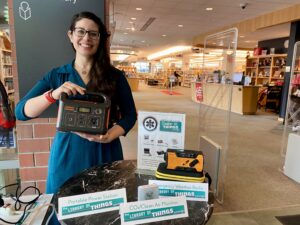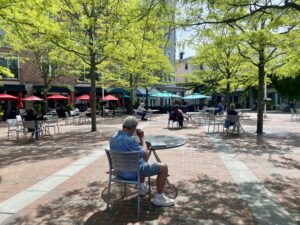
: Becky Bowers, IT manager at the Princeton Public Library, demonstrates the portable power station — just one of the items available for checkout as part of the ‘Library of Things’ program.
This story was produced in collaboration with CivicStory as part of the Ecology Civics Reporting Project.
From hurricane refuge to climate resilience hub, the Princeton Public Library’s ‘Library of Things’ redefines what it means to be prepared.
Princeton, NJ — Memories of the night Hurricane Sandy swept into town still give some Princeton residents the shivers. It was October 29, 2012, and meteorologists had warned this could be the storm of the century. Those in its path stocked up and laid low.
Shelley Krause and Terri Riendeau were two such residents. They lived on a narrow street in Princeton’s Riverside neighborhood. Mindful of the forecasted wind speeds, they bunked down in their living room with their 11-year-old son between them. They reassured him they had camped during thunderstorms before. But privately, Krause and Riendeau listened to the howling wind — “like a tornado, except constant” said Riendeau — and braced for a tree crashing through their roof.
When the lights went out a few hours later, Riendeau and Krause weren’t surprised. Princeton had lost power during Hurricane Irene the year before. The next morning, their street was littered with fallen trees, as were many nearby roads. Moreover, the creeks surrounding the town were flooded, which meant no one could exit or enter by any bridge. Princeton had become an island — one almost entirely without power.
This posed a major problem for Krause. She’s a college counselor at an independent New Jersey high school, and November is crunch month. This is when the first round of college applications is due. The phone lines were down and neither Krause nor Riendeau had smartphones. (It was 2012 after all.) But Krause heard that the Princeton Public Library still had power. To the sound of chainsaw gangs clearing the roads, Krause biked into town.
What she found at the public library has since become community lore. Scores of residents had descended upon the building in search of warmth, electricity, and internet access. People huddled around power sockets hoping to make contact with the outside world. Seeing the demand, staff ran extension cables and surge protectors across the rooms. Rows of residents crammed tables and sprawled on the library floors.
“Everyone went to the Princeton Public Library,” said Riendeau. “The fact that people knew where to go made me feel really good about this town.”
Over the next few days, Krause submitted her students’ college applications, while also touching base with her neighbors. As waves of people came into the library, she described strangers trading stories of how they had made it through the storm.
“You realized the library was the beating heart of Princeton,” said Krause.
That was 13 years ago. Princeton’s power grid has since improved, but Hurricane Ida, which flooded parts of the town in 2021, showed that due to climate change, Princeton is vulnerable to extreme weather. Indeed, climate scientists at the New Jersey Department of Environmental Protection have pored through the projection data and predict that by the end of the century, some counties could see storms 25 percent heavier than they are today. A further analysis by Climate Central, the Princeton-based organization that reports on climate science, shows that as extreme weather becomes more intense, there’s even greater stress on aging energy infrastructure. The result? More frequent power outages.
Library administrators are paying attention. For this reason, alongside regular items such as books and DVDs, Princeton Public Library patrons can also check out a mobile hotspot, an emergency weather radio, or a portable power station. When the next storm hits, library leaders want Princeton’s residents to know: with a bit of planning, you can be ready for anything.
Books, plus
The unconventional items on offer at the Princeton Public Library are part of a larger borrowing category known as the ‘library of things’. The term refers to collections of useful objects that members of a community might only need occasionally — just like with a book. Object collections exist across the world. Some may be borrowed from traditional libraries, while others — such as toy libraries, tool libraries, or art libraries — might be located anywhere the public gathers. In fact, Princeton has more than one library of things; Sustainable Princeton has a lending locker, as does the Center for Modern Aging.
The Princeton Public Library’s first non-literary borrowing item was a kill-a-watt meter. The plug-in device measures an appliance’s electricity consumption. It can be used to calculate the energy costs of common household devices, even when they are switched off. Seven meters had been donated by the Princeton Environmental Commission. Patrons were encouraged to borrow the devices to calculate their appliances’ running costs and to locate the energy vampires in their homes.
But it was the onset of the coronavirus pandemic in 2020 that really shaped their thinking, explained assistant director, Erica Bess. As the entire world moved online, those without wi-fi at home were instantly cut off. Just as Hurricane Sandy had drawn people to the public library to access electricity, so the pandemic drew them back for the wi-fi.
But like schools and offices, the public library was closed. Regardless, residents crowded against the outside walls to tap into the library’s signal. When library staffers realized what the community needed, they broadcast their internet connection onto the adjacent Hinds Plaza, which is both more comfortable than a sidewalk and accommodates many people. The library’s free wifi remains on the plaza today.
Agility in a crisis
The shock of the 2020 pandemic still reverberates. But the experience also highlighted an opportunity. A key pillar of the public library’s strategic plan is to expand access to services. The pandemic revealed how many residents lacked access, not just to the internet at home, but also to the tech gadgets necessary for a world that was suddenly very online.
Accordingly, the Princeton Public Library secured a grant that allowed them to purchase a range of tech items such as mobile hotspots, laptops, and computer media kits. The library gathered these disparate items together and branded it as a Library of Things. Today, the library offers 18 different objects, all of which are paid for by donations or grants. Additions are planned for the future depending on the availability of grant funding as well as patron demand. As Princeton’s needs change, Bess explained, the collection will change with them.
But library leaders had not forgotten that it was an extreme weather event that first highlighted the importance of the library during a crisis. When LibraryLinkNJ invited applications for a resiliency mini-grant called Ready For Anything, the Princeton Public Library leaped at the chance. Their submission, titled Power Up Princeton, made the case for the purchase of 15 portable power stations and 15 crank radios. They would be provided to patrons during power outage emergencies.
Princeton was among thefirst round of grantees, with an award of $5,000. Other grantees included the Hunterdon County Library to fund a solar device charging canopy, and North Bergen Public Library for an emergency generator. Ironically, the grant’s submission deadline was September 2021, the same month Hurricane Ida blasted into New Jersey.
Anytime use
The emergency prep gear didn’t reach Princeton in time for Ida, but patrons have checked them out many times since. Like everything in the Library of Things, patrons can simply borrow the item on their library card. Yet outside the lending period, library administrators do not track who has borrowed what. This is a feature, not a bug, of the system.
“The beauty of a public library is that who you are and why you’re borrowing something is your own business,” said Erica Bess. “We’re just happy to have something that you need.”
However, the library can confidently identify one of its Library of Things borrowers: Princeton Public Library employee, Becky Bowers.
Bowers, manager of the IT department, checked-out the portable power station a few summers ago when a storm left her town of Allentown, NJ, without power for three days. Bowers charged the station at the library and brought it home so her partner, who works remotely, could keep his phone and laptop charged. They have subsequently used it on camping trips, too.
Bower’s experience makes her a good ambassador for the collection, which she demonstrates to patrons at regular public events. On April 3, Bowers laid out the ‘things’ available for check-out at a table by the library’s entrance, alongside similar items from Sustainable Princeton’s lending locker. As patrons browsed the library’s nature packs, smartphone media kits, blue-ray/DVD players, and carbon dioxide monitors, Bowers explained what they were and how to use them.
“When most people think about the library, they think about books,” she said to one patron as he carefully examined the portable power station. But we have other things, too. You can check them out, and it will renew, just like a book.”

The library’s free wi-fi signal was broadcast onto Hinds Plaza during the pandemic and is still available today. (Photo by Carolyn Jones)
Public library = climate solution
The Princeton Public Library promotes its library of things as a practical resource for the community, both during ordinary times and in emergencies. The library also serves as a community warming and cooling center during periods of temperature extremes. Yet as the planet heats up, there will be even more crises ahead. Worse, the Trump Administration has cut funding for both weather forecasting and climate research — notably also at Princeton University, which the Daily Princetonian reported has lost $4 million in research funding. This makes it even harder to anticipate the future.
Fortunately, outside the Trump administration, climate denial is not widespread. Surveys show that a worldwide majority want their governments to take climate action. Actions are bubbling up from communities, too.
For example, Probable Futures, a climate literacy initiative, aims to help people prepare for what’s to come. The organization believes that the better equipped communities are to adapt to climate change, the better their prospects.
Nabig Chaudhry, their director of climate adaptation strategy, noted that the Princeton Public Library is an example of climate adaptation in action. “People often think that climate adaptation involves these really new or novel solutions that don’t exist yet,” Chaudhry said. “The reality is that actually most of what we need to do already is there. Having places like this library, where people can come together, becomes so essential.”
Chaudhry notes that public gathering places are central to community resilience, because in most cases, the first responder in a crisis is likely to be a neighbor. “It means you have a much better chance of weathering climate impacts, adapting to them, and figuring out how to move forward.”
Indeed, moving forward as a community is central to the library’s mission. And as everyday borrowing blends into climate resilience, Princetonians know that no matter the emergencies ahead, the public library’s got their back.
This story was produced in collaboration with CivicStory as part of the Ecology Civics Reporting Project.
Co-published with TAPinto Princeton.

Carolyn Jones is a CivicStory 2025 Ecology-Civics reporting fellow and writes for TAPinto Princeton.
